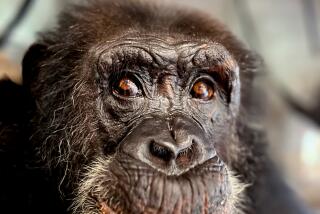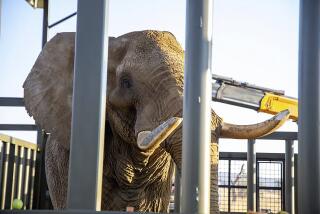Trading the Internet for meerkats, chimps and giraffes in Africa
- Share via
You’ve been on an African safari, you’ve experienced the thrill of seeing the “big five,” but you want more.
But what?
I wanted to take my youngest daughter, Sofia (then 14 and addicted to anything with a screen), to Africa, but I was determined to keep her off the grid and doing something she loved: interacting with animals.
I called my trusted source, Leora Rothschild of Rothschild Safaris, a Colorado-based travel company. The conversation went something like this: “We want luxurious but not excessive camps; no game drives. I’d like to visit traditional villages, and Sofia wants to get within inches of unusual animals.
“Oh, and it would be great if I could keep her off the Internet.”
“Not a problem,” Rothschild replied. “You’ll have to travel farther, and Wi-Fi will be spotty, but it might be there, sorry.”
In three weeks in June, our itinerary took us to Botswana, Tanzania and Kenya. Here’s a sampler from that trek:
Botswana
Jack’s Camp, in the northeastern part of this southern African country, sits in the grasslands beside majestic Makgadikgadi Pans, once a lake covering an area the size of Switzerland.
The camp is named for safari pioneer Jack Bousfield, known for all kinds of bush high jinks. His son, Ralph, an equally dashing filmmaker, safari guide, traveler and naturalist, rebuilt his father’s camp, and it’s become one of the top luxury destinations in Botswana.
Jack’s channels the romance of a 1940s-era African camp. The bedroom tents have four-poster canopy beds, writing desks, piles of Afrophile books and a large deck with chaises.
There is a bathroom at the back, an outdoor shower and every conceivable amenity for contentment in the bush.
Besides touring the salt pans in all-terrain vehicles, this camp’s biggest draw is meerkats, members of the mongoose family. Super, the guide for our four-day stay, asked us to be up by 7 a.m. for our first encounter with the meerkats. Meerkats are extremely social with one another; they live in underground colonies and emerge about 7:30 a.m. each day to seek warmth and food.
Because they are often prey, one member of the colony acts as a sentry and will seek the highest vantage point. Super told Sofia, “Lie here,” pointing to the ground, as we approached their burrow.
It was winter in Botswana, and the mornings were chilly, meaning the meerkats were rising later. Sofia lay on her stomach next to a burrow and shortly, several bright-eyed creatures exited, one bounding up Sofia’s arm and perching on its hind legs on the top of her head, its head swiveling side to side as if it were watching a tennis match. Several others nestled against her for warmth.
She was in heaven, all screens forgotten.
Tanzania
Our next destination was the remote Greystoke Mahale Camp, on the eastern shore of far-off Lake Tanganyika.
The draw here is the chance for encounters with chimpanzees that roam the nearby Mahale Mountains. They first became accustomed to humans in the 1960s when researchers lived among them.
We had just reached our tent when a guide rushed to the door and told us there were chimps in camp. Sofia bounced up and ran off with him. I grabbed my camera and followed.
On a forest path behind the camp, I rounded a corner and saw the guide with Sofia, two female chimps sitting beside her, one leaning against a pant leg, completely comfortable with her presence. I was so shocked that I neglected to use the camera and missed the moment, but it was one we will never forget.
Mahale is also a luxury camp with secluded tents set under thatched A-frame roofs that look over the lake. The tents, or bandas, are simpler than those at Jack’s, with striped fabrics, romantic lanterns, furniture made from wood reclaimed from old dhows and canoes, and a large bathroom and dressing room structure out back. Each night, a fire was lighted under a water tank to provide us with hot water to shower.
We were at Mahale for three days and saw plenty of chimp action.
One morning, we encountered them less than an hour from camp, gorging on mangoes. Mwiga Mambo, our guide, knew each chimp by name and personality.
The drama of the familial relationships was as good as any human soap opera. The first chimp we encountered was Orion, who looked depressed. He sat alone in the middle of the path, head in hands, eyes downcast, ignoring our presence.
“He often gets into trouble,” Mambo whispered. “He tries to molest the females and then he gets beaten and sent away by Kalunde, the respected elder.”
Farther along the path, we saw chimps in the trees and on the ground. A rushing sound and a chimp burst out of the bush in front of us, standing on his back legs.
“It’s just Christmas,” Mambo said. “He’s a naughty teenager. He pretends he’s more important than he is.”
Farther on was Darwin, a kindly male who had been hand-reared and then released. “And this is Xantip. She is very kind and has a baby by wise Kalunde.”
The chimps would often grow bored and push past us. At one point, one sat down in front of me. It took me a moment to realize that he was politely waiting for me to move out of the way rather than shoving me off the path, which he could have done with a bat of a hand.
There is no other experience in the world like spending time in the wild with our closest related species, and for a magical Africa, this place was worth the long haul to get here.
The camp has satellite Wi-Fi, but we had strict instructions to use it only if absolutely necessary. When not searching for chimps, fishing or eating incredible food, Sofia, miraculously, was reading a book.
Kenya
Our last destination was Segera in central Kenya. We broke the trip with two nights at Giraffe Manor in Karen, a suburb of Nairobi, the only place in the world where you wake up to a giraffe knocking on your second-story window demanding breakfast.
Giraffe Manor is literally that, an ivy-clad manor house built in the 1930s by a Scottish industrialist. The property became a sanctuary for the endangered Rothschild giraffe in the 1970s.
In 1983, it was turned into a hotel where guests can interact with and feed the giraffes from their bedroom windows, the ground-floor breakfast room and through the front door, at which the animals often stand with their long necks pushing into the lobby, although they never actually enter. Giraffe Manor was recently purchased and refurbished.
At the first sign of a giraffe outside our window, Sofia was up and feeding it handfuls of kibble from a bucket left in our room. We then headed to breakfast, where she fed them again from her plate, their extravagant eyelashes grazing her shoulder.
From Nairobi, we took a 90-minute flight to Laikipia Plateau in central Kenya, where we were met by the Segera staff and driven two hours to Segera Retreat, a 50,000-acre conservancy owned by Jochen Zeitz, a German entrepreneur, former chief executive of Puma and director of Kering (a luxury group whose brands include Gucci, Stella McCartney and Yves Saint Laurent).
At Segera, walking safaris, rather than game drives, are encouraged. There is an astonishing African art collection, and there are chances to connect with local people.
The lodge itself is spectacular. The six elevated villas are huge and house-like, with stone tubs and a design that incorporates black-and-white African photography. We stayed in a two-bedroom villa so large that Sofia would traipse down the hall to sleep with me, afraid to be alone as fantastic animal noises pierced the nights.
Late one afternoon, we visited a Samburu cow herders’ village, where women, necks weighted with traditional beaded collars, now bead for Western markets through the support of the Zeitz Foundation’s Long Run Initiative, which grades tourism projects on their efforts regarding conservation, community development, culture and commerce. Toward sunset, the men, also decked in traditional beading, came galloping into the village on camelback after a day of herding, posing with great machismo for my photos.
Segera has Wi-Fi, but the staff kept Sofia off the Internet with riverside picnics, among other activities. Of course, as soon as we were back in the land of connectivity, photos of her with giraffes, elephants, meerkats and chimps were posted all over the Internet.
But I reveled in the fact that I’d had three precious weeks with my child without a single FaceTime call.
If you go
Rothschild Safaris; (800) 405-9463. Ten-day safaris beginning at $3,500 per person, based on accommodation type.
More to Read
Sign up for The Wild
We’ll help you find the best places to hike, bike and run, as well as the perfect silent spots for meditation and yoga.
You may occasionally receive promotional content from the Los Angeles Times.






